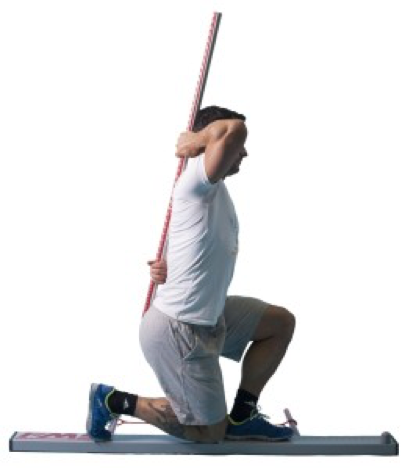Functional Movement Screen (FMS) – and what do research say?
Do you know how many results do you get when you type „Functional Movement Screen“ at Google search engine?
443,000!
That demonstrates the popularity of battery tests that are now being used worldwide. Despite that, not everyone shares the same enthusiasm.
According to Cook: “FMS serves as a risk control tool.” (1) Its role is to identify restrictions in movement patterns and to detect asymmetries between opposite sides of the body. The author states that FMS is not a diagnostic system, but it is used for determining minimum standards for movement patterns in the active population. (1) As such, it has great practical applicability for most coaches and fitness professionals.

Figure 1. Functional movement screening procedure
The FMS was presented to scientific community in 1997 through two articles. Gray Cook later described it more clearly in his book Athletic Body in Balance (2). The detailed version with the instructions appeared in the book Movement. It consists of seven individual tests: deep squat, hurdle step, in-line lunge, shoulder mobility test, active straight leg raise, push-up, rotatory stability. Each test is given a rating of 0 to 3. If the pain is detected, grade 0 is given, if the subject cannot perform the task – 1, if the task is performed with a certain compensation – 2 and rating 3 for the proper performance. (2) In five tests (except for push-ups and deep-squat), the task is performed on both sides of the body and a lower rating is given if one side is worse than the other (e.g. 2 for the left and 3 for the right side of the step on the line makes the total score of 2) with the record of these asymmetries. The maximum possible score is 21, minimal 7, and in most populations, the result is between 13 and 15. (2) When correcting errors, it is recommended that it moves from tests in which the result is 0 and 1 and is continued with reversing assymetries. (1)
Research
FMS has gained big popularity and critics over the last years. However, not to present information that is subjective let’s look at what science tells us on the subject. In 2014 a group of authors published a review paper in Journal of Strength & Conditioning Research. The paper consisted of 33 publications which met the criteria for inclusion. (3) The authors presented the following conclusions about the FMS:
- The number of tests performed is more important than the number of years of work experience. We recommend over 100 measurements for the high level of standardization.
- It is better to evaluate and draw conclusions for each of the 7 tests in particular than on the basis of the total number of points.
- Persons who have a score of less than 14 have an increased risk of injury.
- There is no hard evidence that a better result in FMS means better situational success, i.e. better sport-a specific performance.
- Application of FMS should be in accordance with sport specific individual requirements
- FMS may be an appropriate beginning of musculoskeletal insight and movement analysis in individuals with lower or moderate motor control, while the more sophisticated methods should be applied in top athletes. (3) In other words, if you are a personal trainer and mostly working with amateurs FMS can be of great use in planning and programming training.
In the next review (also meta-analysis), Bonazza and Associates (4) decided to search available research and determine how efficiently FMS can predict injuries. After searching the literature, 11 studies have met the criteria. Six of these were included in the analysis and the conclusion was that the test has excellent reliability, i.e. when measured multiple times by the same 1 or more measurers results are similar. Nine studies met the requirements for quality of injury prediction – All were included in the analysis and it has been found that subjects with a score of less than 14 are 2,74 times more likely to have a locomotor injury than those who achieve a higher score. (4)

In his detailed review Chris Beardsley pointed out the connection between FMS and the following factors:
- Factors affecting success in the test
- Gender: No significant difference (by most examiners)
- Age: Negative correlation with age increase
- Physical activity: A higher level of physical activity associated with a better result in the test
- Postural stability and balance: conducted Test BESS (balance Error Scoring System), no significant links were established between tests
- BMI: Higher BMI means lower test score (with exceptions) Previous injuries: No link to the result
- Disorders in the breathing pattern: a bad test result means a significantly higher chance of a worse result in the FMS
- Competition season (basketball): The total result without change, improvement in deep squat and in-line lunge, but worsening in the active straight leg raise and quadruped rotatory stability
- Deep squat, hurdle step, in-line lunge, shoulder mobility test, active straight leg raise, push-up, quadruped rotatory stability
- Reliability
- Intra-rater: high reliability
- Multiple measurers for the same test (inter-rater): high reliability
- Test-re-test: a less reliable, better performance of the subjects after learning the test
- Validity
- Poor constructional validity (whether the test measures what needs to be measured – in this case compensatory movement patterns)
- Poor criterion validity (comparison of the criteria reference test)
- Poor content validity (proportionally represented by all objects of measurement) and in the context of prevention of injury and efficiency of movement
- Poor concurrent validity (correlation with other similar tests) and in the context of prevention of injuries and efficiency of movement.
- Prevention of injuries
- Subjects who achieve a score of less than 14 have a higher chance of injury (with certain variations in studies).
- Prediction of success in activities
There is no connection to success in sprint-type tasks, quick change of direction or running.
Conclusion
According to Marković, the principles of functional movement are: mobility of joints and flexibility of soft tissue, alignment of joints and spine, proper breathing pattern, good kineesthesia and proprioception, and ultimately the integration of these four principles in movement pattern (motor pattern). (6) The deficit occurring in FMS is inability to determine the problem of a specific principle which may lead to incorrect work recommendations. From the afore mentioned, we can conclude that FMS can be a good test to choose exercises when it comes to amateurs and beginners and as a helping tool to predict the risk of injury, but if we want better and more professional approach we will have to use other tools.
- Cook, G. & and Co, Movement Screening. InMovement Functional Movement Systems: Screening, Assessment and Corrective Strategies. pp. 64–
- Beardsley, C., Functional Movement Screen (FMS).
- Kraus K, Schütz E, Taylor WR, Doyscher R. Efficacy of the functional movement screen: a review.J Strength Cond Res. 2014;28(12):3571-84.
- Bonazza NA, Smuin D, Onks CA, Silvis ML, Dhawan A. 2016. Reliability, Validity, and Injury
- Predictive Value of the Functional Movement Screen: A Systematic Review and Meta-analysis. The American Journal of Sports Medicine,
- Cook, G., What I look for in an FMS score. Functional Movement. 6. Marković, G., 2016. MM
Akademija Funkcionalnog pokreta, Smjer – funkcionalni trening, Seminar 1 Funkcionalni trening pokretljivosti,




